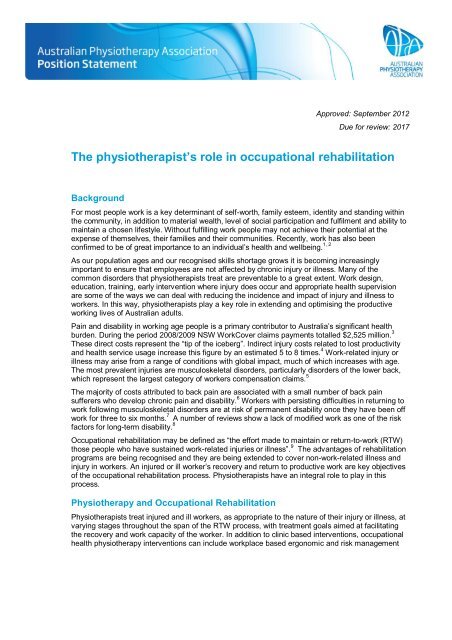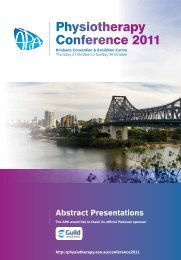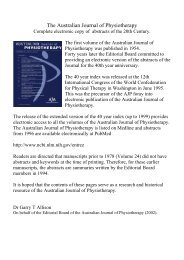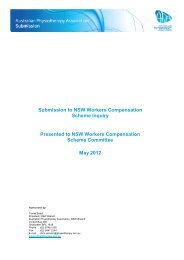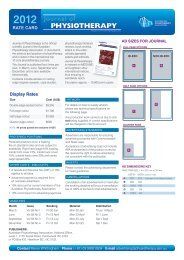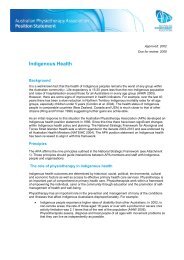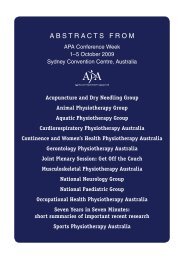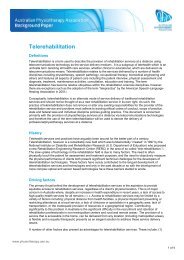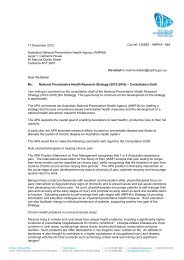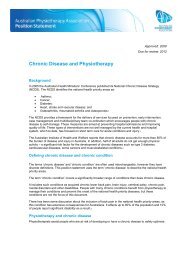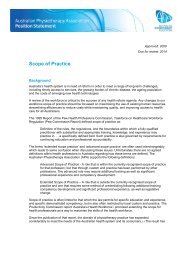The physiotherapist's role in occupational rehabilitation - Australian ...
The physiotherapist's role in occupational rehabilitation - Australian ...
The physiotherapist's role in occupational rehabilitation - Australian ...
You also want an ePaper? Increase the reach of your titles
YUMPU automatically turns print PDFs into web optimized ePapers that Google loves.
Approved: September 2012<br />
Due for review: 2017<br />
<strong>The</strong> physiotherapist’s <strong>role</strong> <strong>in</strong> <strong>occupational</strong> <strong>rehabilitation</strong><br />
Background<br />
For most people work is a key determ<strong>in</strong>ant of self-worth, family esteem, identity and stand<strong>in</strong>g with<strong>in</strong><br />
the community, <strong>in</strong> addition to material wealth, level of social participation and fulfilment and ability to<br />
ma<strong>in</strong>ta<strong>in</strong> a chosen lifestyle. Without fulfill<strong>in</strong>g work people may not achieve their potential at the<br />
expense of themselves, their families and their communities. Recently, work has also been<br />
confirmed to be of great importance to an <strong>in</strong>dividual’s health and wellbe<strong>in</strong>g. 1, 2<br />
As our population ages and our recognised skills shortage grows it is becom<strong>in</strong>g <strong>in</strong>creas<strong>in</strong>gly<br />
important to ensure that employees are not affected by chronic <strong>in</strong>jury or illness. Many of the<br />
common disorders that physiotherapists treat are preventable to a great extent. Work design,<br />
education, tra<strong>in</strong><strong>in</strong>g, early <strong>in</strong>tervention where <strong>in</strong>jury does occur and appropriate health supervision<br />
are some of the ways we can deal with reduc<strong>in</strong>g the <strong>in</strong>cidence and impact of <strong>in</strong>jury and illness to<br />
workers. In this way, physiotherapists play a key <strong>role</strong> <strong>in</strong> extend<strong>in</strong>g and optimis<strong>in</strong>g the productive<br />
work<strong>in</strong>g lives of <strong>Australian</strong> adults.<br />
Pa<strong>in</strong> and disability <strong>in</strong> work<strong>in</strong>g age people is a primary contributor to Australia’s significant health<br />
burden. Dur<strong>in</strong>g the period 2008/2009 NSW WorkCover claims payments totalled $2,525 million. 3<br />
<strong>The</strong>se direct costs represent the “tip of the iceberg”. Indirect <strong>in</strong>jury costs related to lost productivity<br />
and health service usage <strong>in</strong>crease this figure by an estimated 5 to 8 times. 4 Work-related <strong>in</strong>jury or<br />
illness may arise from a range of conditions with global impact, much of which <strong>in</strong>creases with age.<br />
<strong>The</strong> most prevalent <strong>in</strong>juries are musculoskeletal disorders, particularly disorders of the lower back,<br />
which represent the largest category of workers compensation claims. 5<br />
<strong>The</strong> majority of costs attributed to back pa<strong>in</strong> are associated with a small number of back pa<strong>in</strong><br />
sufferers who develop chronic pa<strong>in</strong> and disability. 6 Workers with persist<strong>in</strong>g difficulties <strong>in</strong> return<strong>in</strong>g to<br />
work follow<strong>in</strong>g musculoskeletal disorders are at risk of permanent disability once they have been off<br />
work for three to six months. 7 A number of reviews show a lack of modified work as one of the risk<br />
factors for long-term disability. 8<br />
Occupational <strong>rehabilitation</strong> may be def<strong>in</strong>ed as “the effort made to ma<strong>in</strong>ta<strong>in</strong> or return-to-work (RTW)<br />
those people who have susta<strong>in</strong>ed work-related <strong>in</strong>juries or illness”. 9 <strong>The</strong> advantages of <strong>rehabilitation</strong><br />
programs are be<strong>in</strong>g recognised and they are be<strong>in</strong>g extended to cover non-work-related illness and<br />
<strong>in</strong>jury <strong>in</strong> workers. An <strong>in</strong>jured or ill worker’s recovery and return to productive work are key objectives<br />
of the <strong>occupational</strong> <strong>rehabilitation</strong> process. Physiotherapists have an <strong>in</strong>tegral <strong>role</strong> to play <strong>in</strong> this<br />
process.<br />
Physiotherapy and Occupational Rehabilitation<br />
Physiotherapists treat <strong>in</strong>jured and ill workers, as appropriate to the nature of their <strong>in</strong>jury or illness, at<br />
vary<strong>in</strong>g stages throughout the span of the RTW process, with treatment goals aimed at facilitat<strong>in</strong>g<br />
the recovery and work capacity of the worker. In addition to cl<strong>in</strong>ic based <strong>in</strong>terventions, <strong>occupational</strong><br />
health physiotherapy <strong>in</strong>terventions can <strong>in</strong>clude workplace based ergonomic and risk management
processes, and case management. <strong>The</strong>se processes will assist ill or <strong>in</strong>jured workers to achieve and<br />
susta<strong>in</strong> their RTW and will optimise the worker’s health and well-be<strong>in</strong>g. Physiotherapists recognise<br />
the importance of work-related physical condition<strong>in</strong>g, functional education, RTW plann<strong>in</strong>g,<br />
<strong>in</strong>dependence and self-management.<br />
Excellent cl<strong>in</strong>ical reason<strong>in</strong>g ability, ref<strong>in</strong>ed assessment skills and expert knowledge of physiology,<br />
tissue heal<strong>in</strong>g and biomechanics enable physiotherapists to provide a broad range of services to<br />
assist workers and employers <strong>in</strong> both <strong>in</strong>jury prevention and <strong>in</strong>jury management. Physiotherapists<br />
have extensive knowledge and understand<strong>in</strong>g of the relationship between work history, work<br />
practice, work environment, lifestyle and mechanisms of <strong>in</strong>jury and illness, which allows them to<br />
assess work capacity and identify suitable duties <strong>in</strong> all phases of the <strong>in</strong>jury/illness-recovery<br />
cont<strong>in</strong>uum.<br />
Physiotherapists actively contribute to prevent<strong>in</strong>g long-term disability and work loss through:<br />
1. Early <strong>in</strong>tervention and identification of needs<br />
Physiotherapists possess knowledge and skills that enable early accurate diagnosis of <strong>in</strong>juries or<br />
musculoskeletal problems and timely implementation of appropriate treatment modalities and<br />
<strong>rehabilitation</strong> <strong>in</strong>terventions for <strong>in</strong>jured or ill workers, which may <strong>in</strong>clude referral to other service<br />
providers. Early <strong>in</strong>tervention for <strong>in</strong>jured or ill workers improves health, social, f<strong>in</strong>ancial, <strong>in</strong>terpersonal<br />
and <strong>in</strong>trapersonal outcomes by promot<strong>in</strong>g recovery and prevent<strong>in</strong>g long term disability and work<br />
loss. 10,11,12,13,14,15 Injured or ill workers who stay at work or make a timely RTW avoid isolation from<br />
the workplace and the employer benefits from retention of the worker’s skills, knowledge and<br />
experience. Assessment based on a biopsychosocial model that considers physical, physiological,<br />
psychosocial and environmental factors, <strong>in</strong>clud<strong>in</strong>g workplace organisation, facilitates early accurate<br />
diagnosis and identification of the worker’s needs. Physiotherapists understand the importance of<br />
early notification of <strong>in</strong>jury, <strong>in</strong>itial acute <strong>in</strong>jury management and referral for appropriate management.<br />
Information required for an effective <strong>occupational</strong> <strong>rehabilitation</strong> <strong>in</strong>tervention is obta<strong>in</strong>ed from the<br />
follow<strong>in</strong>g sources:<br />
<br />
<br />
<br />
Interviews with the <strong>in</strong>jured or ill worker and other key stakeholders;<br />
Assessment of the worker’s capabilities and tolerances, with consideration of <strong>in</strong>dividual and<br />
workplace psychosocial factors; 16 and<br />
Job and task analysis.<br />
<strong>The</strong> assessment results should determ<strong>in</strong>e the follow<strong>in</strong>g:<br />
<br />
<br />
<br />
<br />
<br />
<br />
<br />
<br />
<br />
<br />
Rehabilitation goals;<br />
<strong>The</strong> worker’s capabilities;<br />
Past, current and required [recommended] treatment;<br />
<strong>The</strong> worker’s pa<strong>in</strong> attitudes, beliefs, recovery expectations and <strong>in</strong>volvement with worker’s<br />
compensation;<br />
<strong>The</strong> worker’s physical and mental health, social situation and job satisfaction;<br />
<strong>The</strong> <strong>role</strong> requirements, with consideration of pre-<strong>in</strong>jury duties and hours and the worker’s<br />
capacity to meet these, <strong>in</strong>clud<strong>in</strong>g physical and mental job demands, ergonomic factors, risk<br />
and appropriate accommodations and modifications;<br />
Workplace environmental factors relevant to work health, safety and <strong>rehabilitation</strong>, <strong>in</strong>clud<strong>in</strong>g<br />
work relationships and employment arrangements;<br />
Suitable work duties and hours that facilitate recovery and a safe and durable RTW, while<br />
consider<strong>in</strong>g and balanc<strong>in</strong>g the needs of a range of stakeholders;<br />
Appropriate steps for a tailored RTW plan and <strong>rehabilitation</strong> progress;<br />
Barriers to RTW, <strong>in</strong>clud<strong>in</strong>g risk factors; and<br />
www.physiotherapy.asn.au<br />
2 of 8
Support, equipment, activities or modifications to help susta<strong>in</strong> and progress work and<br />
productivity.<br />
Safety, reliability, validity, utility and practicality are important considerations for all work-related<br />
assessments. 17,18,19<br />
2. Cl<strong>in</strong>ical evaluation and treatment<br />
Cl<strong>in</strong>ical evaluation and a range of physiotherapy treatment <strong>in</strong>terventions may reduce disability and<br />
promote return to activity, <strong>in</strong>clud<strong>in</strong>g work. Such <strong>in</strong>terventions should be implemented <strong>in</strong> accordance<br />
with available evidence-based and best-practice guidel<strong>in</strong>es.<br />
3. A focus on early RTW and work ma<strong>in</strong>tenance<br />
Early RTW and work ma<strong>in</strong>tenance are associated with better health outcomes for <strong>in</strong>jured workers 20<br />
and are top priorities <strong>in</strong> <strong>occupational</strong> <strong>rehabilitation</strong>. Early <strong>occupational</strong> <strong>rehabilitation</strong> <strong>in</strong>terventions<br />
with an <strong>in</strong>tegrated worker and work-focused approach facilitate effective communication,<br />
collaboration and a shared commitment to common goals between stakeholders. Research has<br />
found greater RTW success with programs that <strong>in</strong>clude workplace arrangements aimed at facilitat<strong>in</strong>g<br />
RTW. 21,22<br />
4. Development of a supportive workplace culture<br />
Timely <strong>rehabilitation</strong> <strong>in</strong>terventions and appropriate work accommodations for <strong>in</strong>jured and ill<br />
employees make important contributions to a culture of workplace safety and to excellence <strong>in</strong><br />
bus<strong>in</strong>ess management. Return<strong>in</strong>g to productive work follow<strong>in</strong>g <strong>in</strong>jury or illness is recognised as a<br />
socially fragile process. 23 Barnett et al 24 confirm that the workplace has a critical <strong>role</strong> to play <strong>in</strong><br />
achiev<strong>in</strong>g positive RTW outcomes, with specific features of the workplace able to facilitate effective<br />
RTW. A supportive workplace culture is the strongest correlate to effective and durable return to<br />
work. 25,26,27,28,29 Amick, et al 30 found that the rate of RTW six months post-surgery was nearly twice<br />
as high for workers who perceived a higher level of ‘people-oriented culture’ <strong>in</strong> the workplace and<br />
higher safety culture <strong>in</strong>clud<strong>in</strong>g ‘active safety leadership’.<br />
5. Targeted education and self-management focussed on active <strong>rehabilitation</strong><br />
Provid<strong>in</strong>g active <strong>rehabilitation</strong>, rather than simply the provision of symptomatic relief (analgesia and<br />
manual therapies), is an effective way of speed<strong>in</strong>g up RTW and reduc<strong>in</strong>g work loss <strong>in</strong> the longer<br />
term. 31 <strong>The</strong> basic elements of an active <strong>rehabilitation</strong> program <strong>in</strong>clude: advice on activity<br />
management <strong>in</strong>clud<strong>in</strong>g work; graded physical exercise and early resumption of avoided or ceased<br />
activities us<strong>in</strong>g a cognitive behavioural approach 32 , <strong>in</strong>clud<strong>in</strong>g a range of active cop<strong>in</strong>g strategies.<br />
Education should be targeted to meet the specific needs of the worker, based on current evidence,<br />
provided consistently by all stakeholders and be consistent with promot<strong>in</strong>g activity, <strong>in</strong>dependence<br />
and self-management. Appropriate educational topics <strong>in</strong>clude beliefs and attitudes, expectations,<br />
activity, safe work practices, risk management, job and workplace design and an understand<strong>in</strong>g of<br />
<strong>in</strong>jury, pa<strong>in</strong> and the recovery processes. 33,34,35,36<br />
<strong>The</strong> language and procedures of the worker’s compensation system are often unfamiliar and<br />
confus<strong>in</strong>g for workers. This may <strong>in</strong>crease levels of stress and produce an adverse impact on<br />
neurobiopsychosocial pa<strong>in</strong> mechanisms, both of which may impede a timely and effective RTW. 37,38<br />
Physiotherapists have specialised assessment and communication skills and are skilled <strong>in</strong> pr<strong>in</strong>ciples<br />
of adult education <strong>in</strong>clud<strong>in</strong>g accommodation of <strong>in</strong>dividual learn<strong>in</strong>g styles, active and reflective<br />
learn<strong>in</strong>g, goal sett<strong>in</strong>g and problem solv<strong>in</strong>g. Physiotherapists are therefore well placed to <strong>in</strong>form,<br />
educate, guide and support the worker to restore function and achieve timely and effective RTW<br />
6. A planned, <strong>in</strong>tegrated and collaborative multidiscipl<strong>in</strong>ary approach<br />
Physiotherapists are committed to work<strong>in</strong>g with<strong>in</strong> a collaborative, <strong>in</strong>tegrated and multidiscipl<strong>in</strong>ary<br />
model that supports cost-effective and evidence-based RTW plann<strong>in</strong>g and management of <strong>in</strong>jured<br />
www.physiotherapy.asn.au<br />
3 of 8
and ill workers. <strong>The</strong>ir collaborative focus is based on problem solv<strong>in</strong>g, negotiation, conflict resolution<br />
and team build<strong>in</strong>g skills and <strong>in</strong>cludes the development of action plans and strategies for manag<strong>in</strong>g<br />
symptoms and flare-ups. This approach is <strong>in</strong> l<strong>in</strong>e with guidance published by the Head of Workers’<br />
Compensation Authorities (HWCA). 39 Clear and consistent communication and active <strong>in</strong>volvement of<br />
all stakeholders <strong>in</strong> decision-mak<strong>in</strong>g and plann<strong>in</strong>g assists the RTW process. 40,41,42 Conflict<strong>in</strong>g<br />
stakeholder advice can enhance fear and avoidance. 43 Clayton 44 reports that the best RTW results<br />
have come from a comb<strong>in</strong>ation of a workplace <strong>in</strong>tervention <strong>in</strong>volv<strong>in</strong>g a worksite ergonomic<br />
assessment and a cl<strong>in</strong>ical <strong>in</strong>tervention <strong>in</strong>volv<strong>in</strong>g a multidiscipl<strong>in</strong>ary work <strong>rehabilitation</strong> program.<br />
Loisel 45 demonstrated that RTW was 2.4 times faster follow<strong>in</strong>g workplace <strong>in</strong>tervention.<br />
In accordance with HWCA guidel<strong>in</strong>es 46 , physiotherapists <strong>in</strong>volved <strong>in</strong> RTW plann<strong>in</strong>g consider<br />
HWCA’s preferred hierarchy for placement, but not at the expense of the worker’s needs or the<br />
employer’s capacity. Physiotherapists consider personnel, management and <strong>in</strong>dustrial issues <strong>in</strong> the<br />
workplace and adopt strategies to address these issues if they are barriers to the worker’s RTW.<br />
7. Regular monitor<strong>in</strong>g and review<br />
Regular monitor<strong>in</strong>g and review of the <strong>in</strong>jured or ill worker’s progress aga<strong>in</strong>st def<strong>in</strong>ed RTW goals and<br />
risk factors is a recognised service delivery and quality assurance need. Physiotherapists have<br />
observational, analytical and communication skills that enhance the quality of such monitor<strong>in</strong>g,<br />
provid<strong>in</strong>g a nuanced perspective of the worker’s progress, regress or stagnation <strong>in</strong> their<br />
<strong>rehabilitation</strong>. <strong>The</strong>y have the necessary skills to match suitable duties to the <strong>in</strong>jured or ill worker’s<br />
capabilities and to implement regular upgrad<strong>in</strong>g of work hours and suitable duties, to assist recovery<br />
and RTW. Physiotherapists use appropriate tools to assess and monitor work and <strong>rehabilitation</strong><br />
processes, as well as changes <strong>in</strong> work activities and environments.<br />
8. Evaluation<br />
Evaluation of RTW success may <strong>in</strong>clude quality of life measures, successful return to and<br />
ma<strong>in</strong>tenance of pre-<strong>in</strong>jury duties and hours, ongo<strong>in</strong>g use of healthcare services and ma<strong>in</strong>tenance of<br />
functional ga<strong>in</strong>s. 47 This <strong>in</strong>formation can then be <strong>in</strong>corporated <strong>in</strong>to workplace <strong>occupational</strong> health and<br />
safety programs, with the objective of prevent<strong>in</strong>g recurrence of similar <strong>in</strong>juries or illnesses.<br />
Physiotherapists ensure the effectiveness of RTW processes is regularly evaluated us<strong>in</strong>g<br />
appropriate outcome measures, with the objective of cont<strong>in</strong>uous improvement.<br />
<strong>The</strong> APA position<br />
<strong>The</strong> position of the <strong>Australian</strong> Physiotherapy Association (APA) is that:<br />
<br />
<br />
<br />
Physiotherapists work<strong>in</strong>g with <strong>in</strong>jured or ill workers and their employers understand<br />
contemporary <strong>in</strong>jury management practices, as well as relevant legislation and its practical<br />
application to RTW processes. Such knowledge and expert application can positively<br />
impact on health, social, f<strong>in</strong>ancial and personal outcomes of <strong>in</strong>jured or ill workers through<br />
early <strong>in</strong>tervention, treatment and <strong>occupational</strong> <strong>rehabilitation</strong> services.<br />
Physiotherapists understand the benefits of cost-effective and evidence-based <strong>in</strong>jury<br />
management, <strong>rehabilitation</strong> and RTW services, <strong>in</strong>clud<strong>in</strong>g a focus on activity and<br />
<strong>in</strong>dependence and facilitat<strong>in</strong>g <strong>in</strong>terventions that promote the achievement of functional goals<br />
and the <strong>in</strong>jured worker’s self-management of their symptoms.<br />
Physiotherapists recognise and promote the importance of the workplace as the focus for<br />
the <strong>rehabilitation</strong> of <strong>in</strong>jured and ill workers. Treat<strong>in</strong>g physiotherapists, whose scope of<br />
practice <strong>in</strong>cludes competency and experience <strong>in</strong> work health, safety and <strong>rehabilitation</strong> are<br />
well placed to provide RTW services that assist case/claims management and cont<strong>in</strong>uity of<br />
care.<br />
www.physiotherapy.asn.au<br />
4 of 8
Specialist Occupational Health Physiotherapists and APA Occupational Health<br />
Physiotherapists (OHPs) are certified to have additional tra<strong>in</strong><strong>in</strong>g and experience <strong>in</strong> work<strong>in</strong>g<br />
with <strong>in</strong>dividuals and employers to improve the prevention and treatment of work related<br />
<strong>in</strong>jury and illness.<br />
Physiotherapists support and contribute to high-quality research focused on the efficacy,<br />
cost-effectiveness and cont<strong>in</strong>uous improvement of <strong>in</strong>jury management, <strong>rehabilitation</strong> and<br />
RTW services.<br />
Employers, <strong>in</strong>surers, worker’s compensation schemes and other government bodies must<br />
recognise:<br />
1) that early physiotherapy <strong>in</strong>tervention, treatment, health promotion and <strong>occupational</strong><br />
<strong>rehabilitation</strong> services are valuable and effective for both <strong>in</strong>jury management and<br />
prevention. <strong>The</strong>se <strong>in</strong>terventions help prevent the transition of <strong>in</strong>jury and illness from<br />
acute to chronic conditions and optimise the health and wellbe<strong>in</strong>g of the workforce;<br />
2) that the physiotherapists’ understand<strong>in</strong>g of the effect of pathology on an <strong>in</strong>dividual’s<br />
capacity to work places the physiotherapist <strong>in</strong> an important and unique position <strong>in</strong><br />
<strong>in</strong>jury management and vocational <strong>rehabilitation</strong>;<br />
3) and ensure that fund<strong>in</strong>g mechanisms help <strong>in</strong>jured and ill workers to access the<br />
physiotherapy services they need to achieve a durable return to work;<br />
4) the advanced tra<strong>in</strong><strong>in</strong>g and expertise of OHPs and ensure that they facilitate timely<br />
and affordable access to these physiotherapists for all <strong>in</strong>jured and ill workers<br />
through fee structures appropriate to their tra<strong>in</strong><strong>in</strong>g;<br />
5) the importance of appropriate communication, early notification of <strong>in</strong>jury, <strong>in</strong>itial acute<br />
<strong>in</strong>jury management, referral for appropriate management and the need for<br />
identification and removal of barriers to early and appropriate communication and<br />
<strong>in</strong>jury management;<br />
6) and facilitate the provision of services by physiotherapists, that assist employers to<br />
review their workplace safety culture and implement a framework to develop and<br />
ma<strong>in</strong>ta<strong>in</strong> an optimal environment us<strong>in</strong>g participative ergonomics methods; and<br />
7) the requirement for fund<strong>in</strong>g research focussed on improv<strong>in</strong>g <strong>occupational</strong><br />
<strong>rehabilitation</strong> outcomes, us<strong>in</strong>g evidence-based assessment, treatment and<br />
<strong>rehabilitation</strong> <strong>in</strong>terventions.<br />
Whilst <strong>occupational</strong> <strong>rehabilitation</strong> and RTW services mostly apply to workers compensation,<br />
the benefits and relevance of physiotherapy services should be recognised by all<br />
jurisdictions, employers and organisations, Examples of bodies, and organisations which<br />
can benefit from work-related physiotherapy services, <strong>in</strong> addition to workers compensation<br />
authorities <strong>in</strong>clude motor vehicle accident <strong>in</strong>surers, personal and public liability <strong>in</strong>surers,<br />
local, state and national government bodies, private corporations and small bus<strong>in</strong>esses.<br />
References<br />
1. Black D. C. (2008). Work<strong>in</strong>g for a healthier tomorrow: Dame Carol Black's review of the health of<br />
Brita<strong>in</strong>'s work<strong>in</strong>g age population. Norwich: <strong>The</strong> Stationery Office.<br />
www.physiotherapy.asn.au<br />
5 of 8
2. Aylward, M. (2010). Realis<strong>in</strong>g the Health Benefits of Work. Australasian Faculty of Occupational &<br />
Environmental Medic<strong>in</strong>e Position Statement. Available at http://www.racp.edu.au/page/policy-andadvocacy/<strong>occupational</strong>-and-environmental-medic<strong>in</strong>e<br />
3. WorkCover NSW. (2008). Statistical Bullet<strong>in</strong> 2008/2009: NSW Workers Compensation. Available at<br />
http://www.workcover.nsw.gov.au/formspublications/publications/Pages/statisticalbullet<strong>in</strong>20082009<br />
.aspx<br />
4. Massy-Westropp, M., & Rose, D. (2004). <strong>The</strong> impact of manual handl<strong>in</strong>g tra<strong>in</strong><strong>in</strong>g on workplace<br />
<strong>in</strong>juries: A 14 year audit. <strong>Australian</strong> Health Review, 27, 80-87<br />
5. <strong>Australian</strong> Institute of Health and Welfare. (2000). Australia’s health 2000: the seventh biennial<br />
health report of the <strong>Australian</strong> Institute of Health and Welfare. AIHW: Canberra<br />
6. <strong>Australian</strong> Institute of Health and Welfare (2000). Australia’s health 2000: the seventh biennial<br />
health report of the <strong>Australian</strong> Institute of Health and Welfare. AIHW: Canberra<br />
7. Waddell, G. and Burton, K. (1999). Evidence review. In JT Carter and LN Birrell (Eds.)<br />
Occupational Health Guidel<strong>in</strong>es for the Management of Low Back Pa<strong>in</strong> at Work – pr<strong>in</strong>cipal<br />
recommendations. Faculty of Occupational Medic<strong>in</strong>e, London, 2000<br />
8. Anema, J. R., Cuelenaere, A. J., van der Beek, A. J., Knol, D. L., de Vet, H. C. W. and van<br />
Mechelen, W. (2004). <strong>The</strong> effectiveness of ergonomic <strong>in</strong>terventions on return-to-work after low<br />
back pa<strong>in</strong>; a prospective two year cohort study <strong>in</strong> six countries on low back pa<strong>in</strong> patients sicklisted<br />
for 3-4 months. Occup. Environ. Med. 61: 289-294<br />
9. Ellis, N. (2001) Work and Health Management <strong>in</strong> Australia and New Zealand. Oxford University<br />
Press, page 3<br />
10. WorkCover NSW. (2008) Improv<strong>in</strong>g outcomes: Integrated, active management of workers with soft<br />
tissue <strong>in</strong>jury.<br />
11. Kendall NAS, Burton AK, Watson P, Ma<strong>in</strong> CJ, (2009) Tackl<strong>in</strong>g Musculoskeletal Problems: the<br />
Psychosocial flags Framework- A Guide for the Cl<strong>in</strong>ic and Workplace. London: <strong>The</strong> Stationery<br />
Office.<br />
12. Loisel P. (2005). Intervention for return to work–what is really effective? Scand J Work Environ<br />
Health 31:245–247.<br />
13. Loisel P, Lemaire J, Poitras S, et al., (2002) Cost-benefit and cost-effectiveness analysis of a<br />
disability prevention model for back pa<strong>in</strong> management: a six year follow up study. Occup Environ<br />
Med, 59:807–815<br />
14. Pilgrim H, Carroll C, Rick J, Jagger N, Hillage J. (2008) Modell<strong>in</strong>g the Cost Effectiveness of<br />
Intervention Strategies and Policies to Reduce the Number of Employees on Sickness Absence.<br />
London: National Institute for Health and Cl<strong>in</strong>ical Excellence;<br />
15. Bultman U, Sherson D, Olsen J, Lysbeck-Hanson C, Lund T, Kilsgaard J. (2009) Coord<strong>in</strong>ated and<br />
tailored work <strong>rehabilitation</strong>: a randomised controlled trial with economic evaluation undertaken with<br />
workers on sick leave due to musculoskeletal disorders. J Occup Rehabil, 19:81–93<br />
16. ASCC. (2006) Work-related Musculoskeletal Disorders <strong>in</strong> Australia, <strong>Australian</strong> Safety and<br />
Compensation Council April 2006 <strong>Australian</strong> Government Publish<strong>in</strong>g Service, Canberra. Available<br />
at: http://www.ascc.gov.au/ascc<br />
17. Innes, E & Straker, L. (1999a) reliability of work related assessments. Work, 13 (2), 107-124<br />
www.physiotherapy.asn.au<br />
6 of 8
18. Innes, E & Straker, L. (1999b) Validity of work related assessments. Work, 13 (2), 125-152<br />
19. Innes, Ev. (2006), Reliability of work related assessments: An update. International Journal pf<br />
Disability Management Research, 1 (1) 135-148<br />
20. Rueda S., Chambers L., Wilson M., Mustard C., Rourke SB, Bayoumi A., Raboud J., and Lavis J.<br />
(2012) Association of Return<strong>in</strong>g to Work With Better Health <strong>in</strong> Work<strong>in</strong>g-Aged Adults: A Systematic<br />
Review. American Journal of Public Health. March 2012, Vol 102, No. 3.<br />
21. Ellis, N. (2001). Work and Health Management <strong>in</strong> Australia and New Zealand. Oxford University<br />
Press, page 3<br />
22. Phillips, C.J., Phillips, R., Ma<strong>in</strong>, C.J., Watson, P.J., Davies, S., Farr, A., Harper, C., Noble, G.,<br />
Aylward, M., Downton, M., Hale, J. and Packman, J. (2012) <strong>The</strong> cost effectiveness of NHS<br />
physiotherapy support for Occupational Health (OH) services. BMC Musculoskeletal Disorders<br />
2012, 13:29<br />
23. Baril, R., Clarke, J., Friesen, M., Stock, S., Cole, D., Bombardier, C., Cooper, J. and Yassi, A.<br />
(2003). "Management of return-to-work programs for workers with musculoskeletal disorders: a<br />
qualitative study <strong>in</strong> three Canadian prov<strong>in</strong>ces". Social science & medic<strong>in</strong>e (1982) (0277-9536), 57<br />
(11), p. 2101.<br />
24. Barnett, K., Hoardaker, A-L., Spoehr, J. and Parnis, E. (2010). Discussion paper: <strong>The</strong> <strong>role</strong> of the<br />
workplace <strong>in</strong> return to work. Report prepared for WorkCover SA. <strong>Australian</strong> Institute for Social<br />
Research. Available at: www.workcover.com/public/download.aspx?id=3901<br />
25. Clayton, A. (2005) Review of the framework for <strong>rehabilitation</strong> <strong>in</strong> the South <strong>Australian</strong> WorkCover<br />
scheme. Available at: www.workcover.com/custom/files/rehabreviewjune05.pdf<br />
26. Amick III, B.C., Habeck, R.V., Hunt, A., Fossel, A.H., Chap<strong>in</strong>, A., Keller, R.B. and Katz, J.N.. (2000)<br />
"Measur<strong>in</strong>g the impact of organizational behaviors on work disability prevention and management".<br />
Journal of <strong>occupational</strong> <strong>rehabilitation</strong> (1053-0487), 10 (1), p. 21<br />
27. Kenny, D. (1995) "Barriers to <strong>occupational</strong> <strong>rehabilitation</strong>: An exploratory study of long-term <strong>in</strong>jured<br />
workers". <strong>The</strong> Journal of Occupational Health and Safety, Australia and New Zealand (0815-6409),<br />
11 (3), p. 249<br />
28. Roberts-Yates, (2003) "<strong>The</strong> concerns and issues of <strong>in</strong>jured workers <strong>in</strong> relation to claims/<strong>in</strong>jury<br />
management and <strong>rehabilitation</strong>: the need for new operational frameworks". Disability and<br />
Rehabilitation (0963-8288), 25 (16), p. 898<br />
29. Franche, R.L., Cullen,K.,Clarke,J.,Irv<strong>in</strong>,E.,S<strong>in</strong>clair,S.,Frank.J.et al (2005) Workplace based Returnto-Work<br />
Interventions: a Systematic Review of the Quantitative Literature. Journal of Occupational<br />
Rehabilitation, 15, 4, 607-631<br />
30. Amick III, B.C., Habeck, R.V., Hunt, A., Fossel, A.H., Chap<strong>in</strong>, A., Keller, R.B. and Katz, J.N.. (2000)<br />
"Measur<strong>in</strong>g the impact of organizational behaviors on work disability prevention and management".<br />
Journal of <strong>occupational</strong> <strong>rehabilitation</strong> (1053-0487), 10 (1), p. 21<br />
31. Karjala<strong>in</strong>en K, Malmivaara A, van Tulder M, et al (2001) Multidiscipl<strong>in</strong>ary biopsychosocial<br />
<strong>rehabilitation</strong> for subacute low back pa<strong>in</strong> <strong>in</strong> work<strong>in</strong>g-age adults: a systematic review with<strong>in</strong> the<br />
framework of the Cochrane collaboration back review group. Sp<strong>in</strong>e,26:262–269<br />
32. Schonste<strong>in</strong> E, Kenny D, Keat<strong>in</strong>g J, Koes B, Herbert RD. (2003) Physical condition<strong>in</strong>g programs for<br />
workers with back and neck pa<strong>in</strong>: a cochrane systematic review. Sp<strong>in</strong>e, 28:E391–E395<br />
www.physiotherapy.asn.au<br />
7 of 8
33. Baril, R., Clarke, J., Friesen, M., Stock, S., Cole, D., Bombardier, C., Cooper, J. and Yassi, A.<br />
(2003) "Management of return-to-work programs for workers with musculoskeletal disorders: a<br />
qualitative study <strong>in</strong> three Canadian prov<strong>in</strong>ces". Social science & medic<strong>in</strong>e (1982) (0277-9536), 57<br />
(11), p. 2101<br />
34. Godges, J., Anger, M. A., Zimmerman, G. and Delitto, A. (2008) Effects of education on Return-to-<br />
Work status for people with fear-avoidance beliefs and acute low back pa<strong>in</strong>. Physical <strong>The</strong>rapy<br />
88(2): 231-239<br />
35. Gatchel, R.J., Peng, Y.B., Fucks, P.N., Peters, M.L. and Turn, D.C. (2007) <strong>The</strong> Biopsychosocial<br />
Approach to Chronic Pa<strong>in</strong>: Scientific Advances and Future Directions. Psychological Bullet<strong>in</strong><br />
133(4): 581-624<br />
36. McEachen, E., Clarke, J., Franche, R. and Irv<strong>in</strong>, E. (2006) Systematic review of the qualitative<br />
literature on return to work after <strong>in</strong>jury. Scand J Work Environ Health 32(4):257-269<br />
37. Kenny, D. (1995) "Barriers to <strong>occupational</strong> <strong>rehabilitation</strong>: An exploratory study of long-term <strong>in</strong>jured<br />
workers". <strong>The</strong> Journal of Occupational Health and Safety, Australia and New Zealand (0815-6409),<br />
11 (3), p. 249.<br />
38. Roberts-Yates. (2003) "<strong>The</strong> concerns and issues of <strong>in</strong>jured workers <strong>in</strong> relation to claims/<strong>in</strong>jury<br />
management and <strong>rehabilitation</strong>: the need for new operational frameworks". Disability and<br />
Rehabilitation (0963-8288), 25 (16), p. 898<br />
39. HWCA (2005) Guide: Nationally consistent approval framework for workplace <strong>rehabilitation</strong><br />
providers (‘the Guide’) <strong>in</strong> South Australia. Available at: www.hwca.org.au<br />
40. Frank, J., Brooker, A., DeMaio, S., Kerr, M., Maetzel, A., Shannon, H., Sullivan, T., Norman, R.<br />
and Wells, R. (1996) Disability result<strong>in</strong>g from <strong>occupational</strong> low back pa<strong>in</strong>: Part II: What do we know<br />
about secondary prevention? A review of the scientific evidence on prevention after disability<br />
beg<strong>in</strong>s. Sp<strong>in</strong>e, 21(24): 2918-2929.<br />
41. Yassi, A., Ostry, A.S., Spiegel, J., Walsh, G. and de Boer, H.M. (2002) "A collaborative evidencebased<br />
approach to mak<strong>in</strong>g healthcare a healthier place to work." Hospital quarterly (1480-221X), 5<br />
(3), p. 70.<br />
42. Institute of Health and Work. (2004) Workplace-based Return-to-work <strong>in</strong>terventions: A<br />
Systematic Review of the Qualitative and Quantitative literature. Ontario<br />
43. Barnett, K., Hoardaker, A-L., Spoehr, J. and Parnis, E. (2010) Discussion paper: <strong>The</strong> <strong>role</strong> of the<br />
workplace <strong>in</strong> return to work. Report prepared for WorkCover SA. <strong>Australian</strong> Institute for social<br />
research. Available at: www.workcover.com/public/download.aspx?id=3901<br />
44. Clayton, A. (2005). Review of the framework for <strong>rehabilitation</strong> <strong>in</strong> the South <strong>Australian</strong> WorkCover<br />
scheme. Available at: www.workcover.com/custom/files/rehabreviewjune05.pdf<br />
45. Loisel P., Abenhaim L., Durand P., et al. (1997) A population-based, randomized cl<strong>in</strong>ical trial on<br />
back pa<strong>in</strong> management. Sp<strong>in</strong>e ;22: 2911–18<br />
46. HWCA (2005) Guide: Nationally consistent approval framework for workplace <strong>rehabilitation</strong><br />
providers (‘the Guide’) <strong>in</strong> South Australia. Available at: www.hwca.org.au<br />
47. Clayton, A. (2005) Review of the framework for <strong>rehabilitation</strong> <strong>in</strong> the South <strong>Australian</strong> WorkCover<br />
scheme. Available at: www.workcover.com/custom/files/rehabreviewjune05.pdf<br />
www.physiotherapy.asn.au<br />
8 of 8


